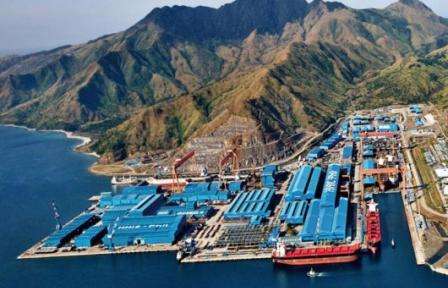Hanjin Heavy Industry will be the next acquisition target?
Publication date:March 6, 2019 Source: International Ship Network
 Hanjin Heavy Industries may become the next acquisition target after it is placed under the management of Korea Industrial Bank (KDB). South Korea's shipbuilding industry will face another big change.
Hanjin Heavy Industries may become the next acquisition target after it is placed under the management of Korea Industrial Bank (KDB). South Korea's shipbuilding industry will face another big change.On February 28, Hanjin Heavy Industries announced that in order to improve its financial situation, Hanjin Heavy Industries will recover 86.3% of its issued shares, including 30.98% of Hanjin Heavy Industries Holdings (HHICH) and 0.5% of Chairman Cho Nam-ho. The remaining shares will be held at a 5:1 ratio, reducing the total equity of Hanjin Heavy Industries from 530.3 billion won to 72.7 billion won (about 64.7 million U.S. dollars).
The process is expected to be completed in May, when Hanjin Heavy Industries Holdings (HHICH), the largest shareholder of Hanjin Heavy Industries, and its chairman, Cho Nam-ho, will no longer own any shares. Hanjin Heavy Industries will be jointly managed by Korea Industrial Bank and other lenders. Cho Nam-ho is the second son of Cho Joong-hoon, the late founder of Hanjin Group.
Hanjin Heavy Industries'creditors plan to appoint Lee Byung-mo, a professor at Renhe University, to replace Cho Nam-ho as general manager of Hanjin Heavy Industries. Lee Byung-mo served as Vice President of Daewoo Shipbuilding in 2011 and President of STX Marine Shipbuilding in 2015. He has rich experience in restructuring the shipbuilding industry.
Industry insiders in South Korea speculate that with Hanjin Heavy Industries being handed over to creditors such as Korea Industrial Bank, Hanjin Heavy Industries may become the next sale target of Korea Industrial Bank after Daewoo shipbuilding. Hanjin Heavy Industries Philippine Sobik Shipyard has been looking for investors willing to take over the operation of the shipyard after filing for bankruptcy in January this year.
In addition, Hanjin Heavy Industries creditors plan to carry out a debt-to-equity swap of 687 billion won ($610 million), of which 160 billion won ($142 million) will be transferred to the Philippine Hanjin Heavy Industries Subik Shipyard. Earlier, Hanjin Heavy Industries has signed a debt-to-equity swap agreement with five Philippine banks to convert Hanjin's $410 million debt into shares, thereby helping the shipyard to continue its operations. At that time, Hanjin Heavy Industries said it was also negotiating similar debt-to-equity swaps with Korean creditors such as Korea Industrial Bank (KDB).
It is understood that Hanjin Heavy Industries owns two shipyards, including the Shadow Island Shipyard in Busan and the Sobik Shipyard in the Philippines. Among them, Yingdao Shipyard was founded in 1937 and was the first shipyard in Korea. In 2015, Hanjin Heavy Industry Group once had sales revenue of 2.5 billion US dollars, ranking tenth in the world.
Hanjin Heavy Industry Film Island Shipyard is located near the old urban area of Busan, with a total area of 260000 square meters, surrounded by residential and commercial office areas, so it is difficult to renovate and expand. Limited by the trend of large-scale shipping, Yingdao Shipyard is no longer suitable for building large merchant ships. In recent years, the construction of Hanjin Heavy Industry's merchant ships has been basically completed by the Sobik Shipyard, while the Shadow Island Shipyard is mainly engaged in the construction of special ships.
Clarkson's data show that Hanjin Heavy Industries Yingdao Shipyard last received merchant ship orders in 2015, when Belgian shipowner CMB ordered two 1922TEU container ships under Hanjin Heavy Industries, and the new ship was delivered in 2017. In January this year, Shadow Island Shipyard delivered the last new ship under construction, a training ship for Quannan University in Korea.
